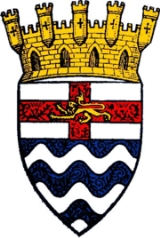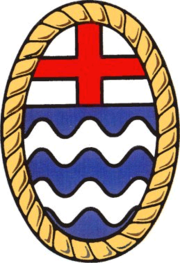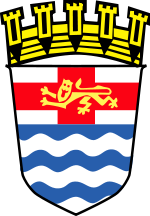
Coat of arms of London County Council
Encyclopedia
The London County Council
was granted a coat of arms
in 1914 and a heraldic badge
in 1956. The coat of arms can still be seen on buildings constructed by the council before its abolition in 1965.
or otherwise take steps to obtain a coat of arms, with a view to commemorating worthily its work in connection with public improvements, such as the construction of new streets and bridges, the restoration of ancient buildings and the like." No further action appears to have been taken until February 1911, when the committee recommended that a coat of arms be obtained at a cost not exceeding £100. The recommendation was rejected by the council, with one member stating that the letters "L.C.C." would be good enough for the council. Another councillor sarcastically suggested the arms of the council should include, among other things, a wrecked ship, the shut gates of the work department and a tombstone to the memory of municipal enterprise with the motto "ad quod damnum
".
In 1914 the council chairman, Cyril Cobb offered to defray the cost of obtaining a grant of arms. Following discussions with the College of Arms, a design was submitted by the general purposes committee to the council on 24 February. The shield or arms featured a cross bearing an imperial crown between in the first and fourth quarters a depiction of the Tower of London
, and in the second and third an ancient galley. A lion of England was to be shown the chief, or upper third of the shield. The suggested crest was a lion issuing from a mural crown and holding a banner of Saint George
. The supporters were to be a Roman officer-of-arms and a Saxon warrior. The Latin
motto loci dulcedo nos attinet or the pleasantness of the place holds us was suggested. This was adapted from the Annals of Tacitus
, and was stated to be the earliest mention of London in history.
The towers were to represent strength and the galleys the shipping interests of the Metropolis. The cross, imperial crown and the lion in the crest were to show that London was the capital of the British Empire
. The mural crown symbolised municipal government. The supporters illustrated the origins and early history of the city.
The final design for the arms, which was "simple in character and in every way suggestive of the corporate life of London", was agreed by the council on 26 May 1914. The arms were blazoned as:
The blue and silver waves represented the River Thames
and the Port of London
. The English lion on a St George's cross was to show that London was the royal centre of London. The gold mural crown was to indicate that the arms were those of a municipal body.
As the arms included part of the royal arms (the English lion) a royal warrant
was issued granting the arms on 29 July 1914. The arms were registered at the college of arms by letters patent
dated 20 October 1914.
In 1953 a new representation of the arms, still agreeing with the 1914 blazon was adopted by the county council.
 The arms granted in 1914 could only be used by the county council itself. The council decided that it required an emblem which it could allow clubs and societies associated with the County of London
The arms granted in 1914 could only be used by the county council itself. The council decided that it required an emblem which it could allow clubs and societies associated with the County of London
to use. Accordingly, they applied for the grant of an heraldic badge. The badge was granted by letters patent dated 12 March 1956, and was blazoned:
The badge repeated the main motifs from the arms: the blue and silver waves and cross of St George. The badge was encircled by a golden rope for the maritime associations of the county. The council permitted "organisations, societies, clubs and other bodies having a connection or association with the County of London" to display the badge subject to conditions imposed by the council.
London County Council
London County Council was the principal local government body for the County of London, throughout its 1889–1965 existence, and the first London-wide general municipal authority to be directly elected. It covered the area today known as Inner London and was replaced by the Greater London Council...
was granted a coat of arms
Coat of arms
A coat of arms is a unique heraldic design on a shield or escutcheon or on a surcoat or tabard used to cover and protect armour and to identify the wearer. Thus the term is often stated as "coat-armour", because it was anciently displayed on the front of a coat of cloth...
in 1914 and a heraldic badge
Heraldic badge
A heraldic badge is an emblem or personal device worn as a badge to indicate allegiance to or the property of an individual or family. Medieval forms are usually called a livery badge, and also a cognizance...
in 1956. The coat of arms can still be seen on buildings constructed by the council before its abolition in 1965.
Background and initial designs
By 1894 the LCC had adopted a device consisting of "an armed female figure between the armorial bearings of the Cities of London and Westminster". The question of an official coat of arms for the county council was first raised at a meeting of the council in 1897. Despite the opposition of two members on the grounds that it was "an insidious attempt to undermine the democratic character of the Council" and, jokingly, that they should not "degenerate to the level of the City Corporation", the General Purposes Committee were instructed to take steps to obtain a coat of arms. Nothing seems to have come of this, and the unofficial device continued in use. In May 1906 the general purposes committee was asked to consider and report on whether the council should make an "application to the College of ArmsCollege of Arms
The College of Arms, or Heralds’ College, is an office regulating heraldry and granting new armorial bearings for England, Wales and Northern Ireland...
or otherwise take steps to obtain a coat of arms, with a view to commemorating worthily its work in connection with public improvements, such as the construction of new streets and bridges, the restoration of ancient buildings and the like." No further action appears to have been taken until February 1911, when the committee recommended that a coat of arms be obtained at a cost not exceeding £100. The recommendation was rejected by the council, with one member stating that the letters "L.C.C." would be good enough for the council. Another councillor sarcastically suggested the arms of the council should include, among other things, a wrecked ship, the shut gates of the work department and a tombstone to the memory of municipal enterprise with the motto "ad quod damnum
Ad quod damnum
Ad quod damnum or ad damnum is a Latin phrase meaning "According to the harm" or "appropriate to the harm." It is used in tort law as a measure of damage inflicted, and implying a remedy, if one exists, ought to correspond specifically and only to the damage suffered. It is also used in pleading,...
".
In 1914 the council chairman, Cyril Cobb offered to defray the cost of obtaining a grant of arms. Following discussions with the College of Arms, a design was submitted by the general purposes committee to the council on 24 February. The shield or arms featured a cross bearing an imperial crown between in the first and fourth quarters a depiction of the Tower of London
Tower of London
Her Majesty's Royal Palace and Fortress, more commonly known as the Tower of London, is a historic castle on the north bank of the River Thames in central London, England. It lies within the London Borough of Tower Hamlets, separated from the eastern edge of the City of London by the open space...
, and in the second and third an ancient galley. A lion of England was to be shown the chief, or upper third of the shield. The suggested crest was a lion issuing from a mural crown and holding a banner of Saint George
Saint George
Saint George was, according to tradition, a Roman soldier from Syria Palaestina and a priest in the Guard of Diocletian, who is venerated as a Christian martyr. In hagiography Saint George is one of the most venerated saints in the Catholic , Anglican, Eastern Orthodox, and the Oriental Orthodox...
. The supporters were to be a Roman officer-of-arms and a Saxon warrior. The Latin
Latin
Latin is an Italic language originally spoken in Latium and Ancient Rome. It, along with most European languages, is a descendant of the ancient Proto-Indo-European language. Although it is considered a dead language, a number of scholars and members of the Christian clergy speak it fluently, and...
motto loci dulcedo nos attinet or the pleasantness of the place holds us was suggested. This was adapted from the Annals of Tacitus
Tacitus
Publius Cornelius Tacitus was a senator and a historian of the Roman Empire. The surviving portions of his two major works—the Annals and the Histories—examine the reigns of the Roman Emperors Tiberius, Claudius, Nero and those who reigned in the Year of the Four Emperors...
, and was stated to be the earliest mention of London in history.
The towers were to represent strength and the galleys the shipping interests of the Metropolis. The cross, imperial crown and the lion in the crest were to show that London was the capital of the British Empire
British Empire
The British Empire comprised the dominions, colonies, protectorates, mandates and other territories ruled or administered by the United Kingdom. It originated with the overseas colonies and trading posts established by England in the late 16th and early 17th centuries. At its height, it was the...
. The mural crown symbolised municipal government. The supporters illustrated the origins and early history of the city.
Grant of arms
 |
 |
The final design for the arms, which was "simple in character and in every way suggestive of the corporate life of London", was agreed by the council on 26 May 1914. The arms were blazoned as:
- Barry wavy of six azure and argent, on a Chief of the last the cross of St George charged with a lion of England, the shield ensigned with a Mural Crown gold"
The blue and silver waves represented the River Thames
River Thames
The River Thames flows through southern England. It is the longest river entirely in England and the second longest in the United Kingdom. While it is best known because its lower reaches flow through central London, the river flows alongside several other towns and cities, including Oxford,...
and the Port of London
Port of London
The Port of London lies along the banks of the River Thames from London, England to the North Sea. Once the largest port in the world, it is currently the United Kingdom's second largest port, after Grimsby & Immingham...
. The English lion on a St George's cross was to show that London was the royal centre of London. The gold mural crown was to indicate that the arms were those of a municipal body.
As the arms included part of the royal arms (the English lion) a royal warrant
Royal Warrant
Royal warrants of appointment have been issued for centuries to those who supply goods or services to a royal court or certain royal personages. The warrant enables the supplier to advertise the fact that they supply to the royal family, so lending prestige to the supplier...
was issued granting the arms on 29 July 1914. The arms were registered at the college of arms by letters patent
Letters patent
Letters patent are a type of legal instrument in the form of a published written order issued by a monarch or president, generally granting an office, right, monopoly, title, or status to a person or corporation...
dated 20 October 1914.
In 1953 a new representation of the arms, still agreeing with the 1914 blazon was adopted by the county council.
Heraldic badge

County of London
The County of London was a county of England from 1889 to 1965, corresponding to the area known today as Inner London. It was created as part of the general introduction of elected county government in England, by way of the Local Government Act 1888. The Act created an administrative County of...
to use. Accordingly, they applied for the grant of an heraldic badge. The badge was granted by letters patent dated 12 March 1956, and was blazoned:
- An oval azure charged with two bars wavy argent, on a chief of the last a cross throughout gules, the whole encompassed by a rope or.
The badge repeated the main motifs from the arms: the blue and silver waves and cross of St George. The badge was encircled by a golden rope for the maritime associations of the county. The council permitted "organisations, societies, clubs and other bodies having a connection or association with the County of London" to display the badge subject to conditions imposed by the council.

